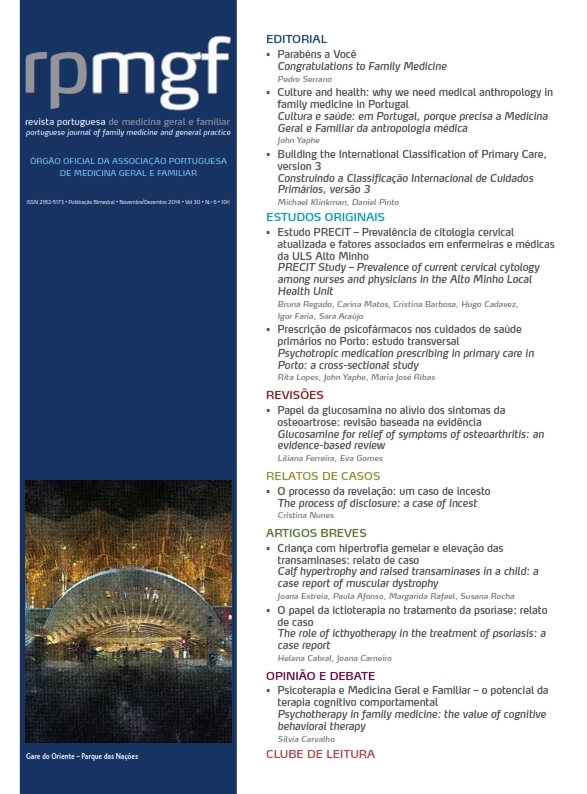Glucosamine for relief of symptoms of osteoarthritis: an evidence-based review
DOI:
https://doi.org/10.32385/rpmgf.v30i6.11402Keywords:
Glucosamine, Osteoarthritis, ArthralgiaAbstract
Objective: Osteoarthritis (OA) is a major cause of pain and disability in the elderly. Glucosamine has attracted interest as a drug for pain relief or improvement of joint function in OA. It appears to be safe. However, many studies have shown different levels of effectiveness, so its use remains controversial. The aim of this study was to review the evidence on the efficacy and safety of glucosamine in the relief of symptoms of OA. Data Sources: Cochrane Library, PubMed, National Guideline Clearinghouse, DARE, TRIP Database, Bandolier, Index of Portuguese Medical Journals. Methods: Meta-analyses (MA), systematic reviews, randomized controlled trials (RCT) and clinical guidelines (CG) published between 01/2009 and 12/2012 were selected, using the MeSH terms osteoarthritis and glucosamine and corresponding DeCS (Portuguese search terms). We used the Strength of Recommendation Taxonomy (SORT) scale of American Family Physician to assign levels of evidence and strength of recommendations. Results: From the 200 articles obtained, four met the inclusion criteria, including two MA, one RCT and one CG, representing 9428 patients studied. Three articles showed that use of glucosamine had some benefit in relieving pain and improving joint function, but this benefit is not statistically or clinically significant compared to placebo. Glucosamine was found to be as safe as placebo. The CG does not recommend the use of glucosamine in OA. Conclusion: The current available evidence suggests that benefits of glucosamine are not clinically significant in the relief of symptoms of OA, particularly in relieving pain and improving joint function (SOR A). However, it is safe (SOR A). Future studies evaluating the cost/benefit ratio of glucosamine for symptom relief may encourage or discourage its use, particularly with co-payment for treatment by the National Health Service.Downloads
Downloads
Published
Issue
Section
License
The authors will assign to the RPMGF the sole right to publish and distribute the content of the manuscript specified in this declaration via physical, electronic, broadcasting or any other medium that may come into existence. They also grant the RPMGF the right to use and exploit this manuscript, in particular by assigning, selling or licensing its content. This permission is permanent and takes effect from the moment the manuscript is submitted, has the maximum duration allowed by applicable Portuguese or international law and is of worldwide scope. The authors further declare that this assignment is made free of charge. If the RPMGF informs the authors that it is not going to publish their manuscript, the exclusive assignment of rights ceases forthwith.
The authors authorise the RPMGF (or any entity it may appoint) to act on their behalf when it believes that copyright may have been infringed.





